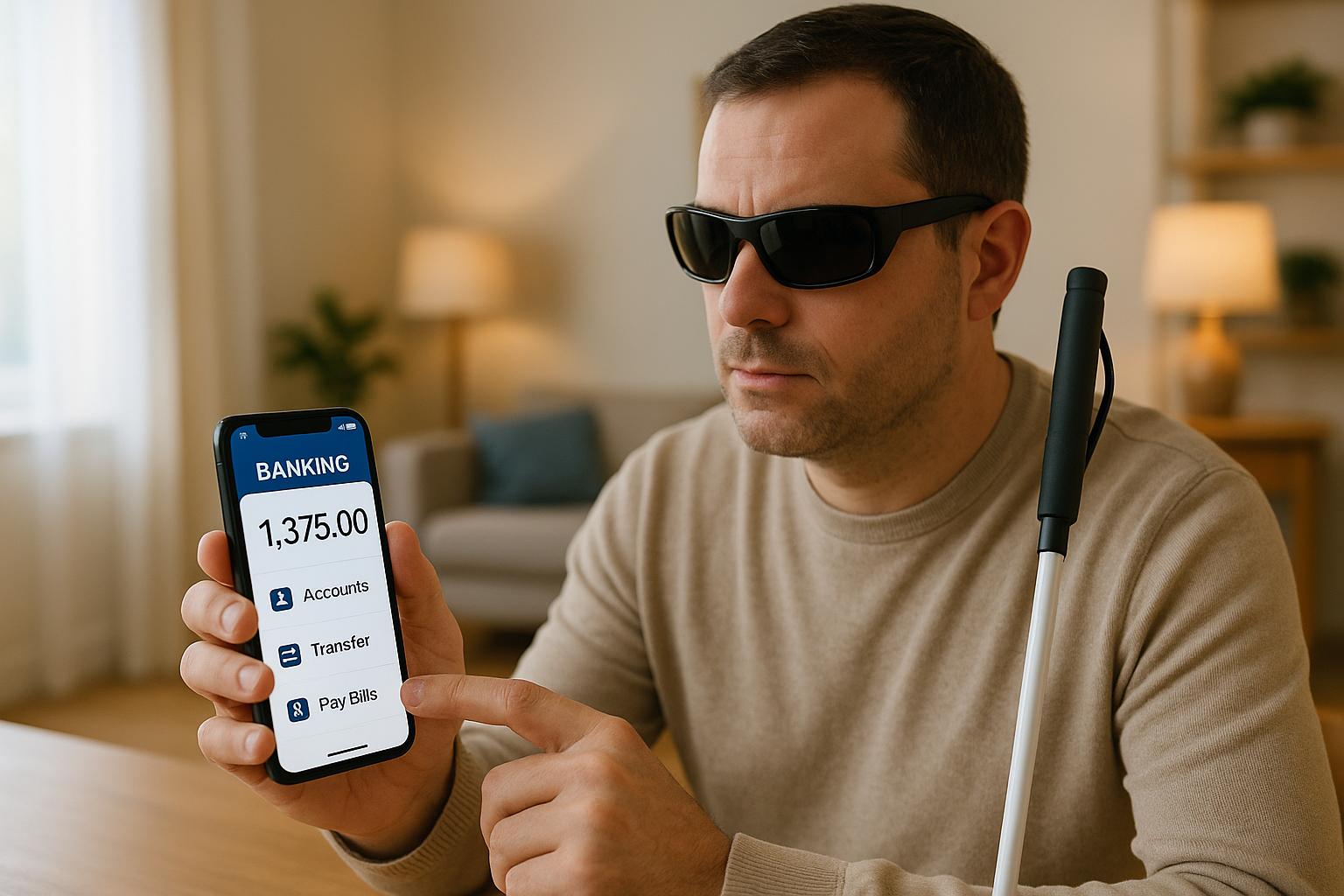ADA compliance for mobile banking apps is not just a legal requirement – it ensures equal access for users of all abilities. Here’s what you need to know:
- What is ADA Compliance? Mobile banking apps must meet WCAG 2.1 Level AA standards to ensure accessibility for users with visual, auditory, physical, cognitive, and neurological disabilities.
- Why it Matters: Over 61 million U.S. adults live with a disability, representing $490 billion in disposable income. Inaccessible apps alienate this audience and pose legal and reputational risks.
- Key Standards: ADA compliance is guided by four principles: Perceivable, Operable, Understandable, and Robust (POUR). These principles ensure apps are usable by everyone, including those relying on assistive technologies like screen readers.
- Common Issues: Barriers like poor color contrast, missing labels, and inaccessible authentication methods can make apps difficult to use. Fixing these issues involves improving design, testing with assistive tools, and offering flexible authentication options.
- Maintaining Compliance: Regular audits, user feedback, and team training are critical to staying compliant as standards evolve.
Quick Steps to Compliance:
- Conduct accessibility audits using automated and manual testing.
- Fix issues like poor contrast, small touch targets, and missing semantic markup.
- Test with users with disabilities to identify real-world barriers.
- Train your team on accessibility best practices and WCAG standards.
- Schedule regular reviews to ensure your app remains accessible.
By meeting ADA standards, you not only avoid legal risks but also make your app usable for a broader audience while improving the overall experience.
ADA Compliance for Websites, Mobile Apps, and other Technology
ADA and WCAG Standards for Mobile Apps
When it comes to ensuring ADA compliance in mobile banking apps, financial institutions need to follow the guidelines outlined in the Web Content Accessibility Guidelines (WCAG). While the ADA provides the legal foundation, WCAG offers the technical instructions needed to achieve accessibility. Together, they create a comprehensive framework for making mobile banking apps accessible to everyone, including users with disabilities.
WCAG 2.1 Level AA Standards Overview
WCAG serves as the primary technical standard for ensuring ADA compliance in mobile apps. Courts often refer to WCAG as the benchmark for accessibility, making WCAG 2.1 and 2.2 Level AA conformance essential for mobile banking apps. Meeting these standards ensures that financial institutions align with ADA requirements.
Over time, WCAG has evolved to address accessibility challenges specific to mobile devices. WCAG 2.1 introduced 17 new criteria tailored to mobile accessibility, while the latest update, WCAG 2.2, added nine more. These updates include recommendations for touch targets, responsive design, and gestures.
The guidelines cover common mobile app challenges like small screens, orientation shifts, contrast ratios, spacing, and keyboard navigation. For mobile banking apps, this means users can complete essential tasks – like checking their balance or transferring funds – regardless of their accessibility needs.
WCAG 2.1 Level AA is the standard most accessibility regulations reference worldwide. This is especially important as nearly 80% of users with disabilities rely on screen readers to navigate digital platforms.
4 Main Accessibility Principles
WCAG is built on four core principles – Perceivable, Operable, Understandable, and Robust (POUR). These principles provide the foundation for creating accessible mobile banking experiences.
| Principle | Description | Mobile Banking Application |
|---|---|---|
| Perceivable | Content must be presented in a way users can perceive | Providing text alternatives for charts, ensuring proper color contrast, and adding captions to videos. |
| Operable | Navigation and interface components must be usable by all users | Ensuring buttons are keyboard-accessible, allowing sufficient session time, and sizing touch targets appropriately. |
| Understandable | Information and user interfaces must be easy to understand | Using clear language, offering helpful error messages, and maintaining consistent navigation. |
| Robust | Content must function across a range of devices and assistive technologies | Ensuring compatibility with screen readers like VoiceOver and TalkBack, and using proper coding practices. |
Each principle is tied to specific technical criteria. For instance, under the Perceivable principle, Success Criterion 1.4.3 (Contrast Minimum) requires a color contrast ratio of at least 4.5:1 for text, ensuring users with low vision can easily read account details.
The Operable principle focuses on enabling interaction through various input methods, such as touch, voice commands, or assistive technologies. For example, critical functions like bill payments or fund transfers should not depend on complex gestures that some users might find challenging.
Recent Department of Justice Updates
The Department of Justice (DOJ) has clarified how ADA standards apply to mobile banking apps. The DOJ now recognizes WCAG as the compliance standard and considers websites and mobile apps as "places of public accommodation" under Title III of the ADA. While the ADA does not provide specific technical requirements for digital accessibility, WCAG offers clear criteria for meeting compliance.
For financial institutions, this means mobile banking apps must provide the same level of accessibility as physical bank branches. Users with disabilities should be able to perform all essential banking tasks – like depositing checks or transferring funds – through the app, just as they could in person or via other methods.
"WCAG compliance is often used in the digital accessibility industry, but WCAG conformance is a more accurate term. WCAG is a voluntary set of guidelines, not a law, which means it’s not something you can comply with. You can, however, conform to the guidelines included in WCAG."
- Jeff Curtis, Sr. Content Manager
This distinction is key for financial institutions. While WCAG itself is not legally binding, conforming to its standards has become the accepted way to meet ADA requirements for digital platforms. Level AA conformance is widely seen as a practical and effective goal for organizations, including those developing mobile banking apps. By aligning with these standards, financial institutions can ensure their apps meet both legal and user expectations for accessibility.
How to Ensure ADA Compliance in Mobile Banking Apps
To make your mobile banking app ADA-compliant, it’s essential to follow the Web Content Accessibility Guidelines (WCAG) while focusing on thorough audits, thoughtful design, and consistent remediation efforts. Financial institutions must identify accessibility barriers, implement effective solutions, and maintain compliance through ongoing processes.
Running Accessibility Audits
The first step toward ADA compliance is conducting detailed accessibility audits. This includes a mix of automated tests, manual reviews, and input from real users. Start by defining the scope of your audit – evaluate all critical app features to ensure they align with WCAG standards.
Automated testing is a great way to catch common accessibility issues early. Tools like BrowserStack allow cloud-based testing on real Android and iOS devices, while Google Accessibility Scanner evaluates Android app UI components and offers improvement suggestions. For iOS apps, Xcode Accessibility Inspector can help you review accessibility properties and simulate VoiceOver interactions. These tools can pinpoint problems like missing alternative text, poor heading structure, and insufficient color contrast.
However, not all issues can be spotted by automation. Manual audits are crucial for uncovering more complex barriers. Use tools like TalkBack on Android or VoiceOver on iOS to experience the app from the perspective of users with visual impairments. Additionally, involve users with disabilities in testing to gain insights into real-world challenges, such as navigating authentication processes with assistive technologies.
Document your findings with screenshots and references to WCAG criteria. This documentation is essential – not only for legal compliance but also to guide development teams in addressing the issues effectively.
Once your audit is complete, shift focus to designing solutions that tackle the identified barriers.
Design Best Practices for Accessibility
When designing for accessibility, consider the diverse needs of your users. For example, ensure touch targets are large and spaced well enough for accurate interaction. This is especially important for banking apps, where users often need to select account numbers or confirm transactions.
Adapt your design to different screen sizes by accounting for various aspect ratios and reducing on-screen clutter. Since banking apps often display complex data, breaking it into smaller, easier-to-read sections – like digestible account summaries or transaction lists – can significantly improve usability.
Color contrast is another critical factor. Mobile devices are often used outdoors, where bright light can make screens harder to read. Ensuring strong contrast helps keep account information legible, even in challenging lighting conditions. Pay special attention to text overlaid on graphs or charts, such as those showing spending trends or investment performance.
Simple gestures and clear feedback enhance navigation. For key functions like transfers or payments, prioritize straightforward tap gestures with clear confirmation steps, avoiding complex swipe patterns. Consistent layouts across your app also help users, particularly those with cognitive disabilities, navigate more confidently.
Data entry is a frequent task in banking apps, so make it as simple as possible. Features like dropdown menus for common payees, autofill options for routing numbers, and radio buttons for transfer frequencies can reduce typing errors and make interactions smoother.
After designing with accessibility in mind, focus on fixing existing issues and keeping detailed records.
Fixing Issues and Keeping Records
Once you’ve identified accessibility barriers, prioritize fixes for essential functions like logging in, checking balances, and transferring funds.
Make sure actions only occur when users clearly intend them to. For example, include confirmation steps for transactions, allowing users to review details before finalizing payments. Increase the size of touch targets for easier interaction, and provide options to cancel or reverse actions before they are completed. Use the "up-event" to undo actions triggered by the "down-event", reducing the risk of accidental transactions.
After implementing fixes, retest using the same methods to confirm WCAG compliance. Align each fix with WCAG criteria to maintain accessibility standards.
Keep using your audit report to track progress. This documentation not only demonstrates compliance efforts to regulators but also helps development teams stay organized and serves as a reference for future updates.
To maintain accessibility as your app evolves, schedule regular audits and provide ongoing training on updated accessibility practices. Incorporate accessibility checkpoints into your quality assurance process and evaluate all new features before they go live. This proactive approach ensures that your app continues to meet user needs and remains compliant over time.
sbb-itb-880d5b6
Common Accessibility Problems in Mobile Banking Apps
Mobile banking apps face unique challenges when it comes to accessibility, often leaving millions of users unable to manage their finances effectively. With 78% of U.S. adults preferring mobile banking and 1 in 4 living with a disability, it’s clear that financial institutions need to address these barriers to serve all customers. Let’s explore the most common issues and practical solutions.
Most Common Accessibility Barriers
One of the most prevalent issues is color contrast failures. A 2021 review revealed that a major national bank’s app had over 10,000 WCAG (Web Content Accessibility Guidelines) violations related to color contrast alone. For users with visual impairments, this makes it difficult to read key information like account balances or transaction details.
Another major hurdle is missing semantic markup. Without proper structure – such as headings, labels, and landmarks – screen readers can’t navigate content effectively. This leads to repetitive or confusing prompts, making tasks like transferring funds or paying bills unnecessarily complicated.
Unlabeled form fields are another obstacle. For example, users relying on assistive technology might struggle to differentiate between fields for routing numbers and account numbers during transactions or account setup. This lack of clarity can render apps nearly impossible to use.
For users with motor impairments, poor touch target design creates additional challenges. Small, closely packed interactive elements increase the likelihood of accidental taps, such as unintentionally transferring money or making an incorrect payment – especially on smaller screens.
Lastly, excessive animations and auto-playing content can cause discomfort or disorientation for users with motion sensitivity.
Secure Authentication Challenges
Balancing security with accessibility is critical but often mishandled. Many traditional authentication methods create barriers for users with disabilities, particularly when alternative solutions aren’t available.
CAPTCHA systems are a prime example. Visual CAPTCHAs exclude users with visual impairments, while audio versions can be equally difficult to navigate. Time-sensitive authentication processes also pose challenges for users who need additional time, and overly complex password requirements can add unnecessary frustration.
WCAG 2.1 Success Criterion 3.3.7 addresses these issues:
"For each step in an authentication process that relies on a cognitive function test, at least one other authentication method is available that does not rely on a cognitive function test, or a mechanism is available to assist the user in completing the cognitive function test."
Two-factor authentication (2FA) can either help or hinder accessibility based on its design. While SMS-based systems are convenient for many, methods relying exclusively on visual QR codes or time-sensitive authenticator apps without alternatives can exclude users.
How to Fix These Barriers
Tackling these challenges requires thoughtful design changes and inclusive alternatives.
- Improve color contrast by ensuring text meets the 4.5:1 ratio and offering high-contrast modes.
- Enhance semantic markup with ARIA (Accessible Rich Internet Applications) labels, logical heading structures, and clear form field descriptions to support screen reader navigation.
- Expand touch targets to at least 44×44 pixels to minimize accidental taps.
- Provide motion settings that let users disable auto-play content, reduce animations, or adjust motion effects.
For authentication, offer flexible options like biometrics (fingerprint or facial recognition), password manager compatibility, and gesture-based logins. Additionally, allow users to extend or disable time limits during authentication to reduce pressure.
The most effective way to ensure these solutions work? Test them with users who rely on assistive technology. By doing so, financial institutions can meet ADA requirements while creating a more inclusive experience for all. Accessibility isn’t just a compliance issue – it’s about making mobile banking usable for everyone.
Maintaining Compliance Over Time
ADA compliance isn’t something you achieve once and forget – it’s an ongoing commitment. With the fast-paced evolution of the mobile landscape, keeping your app accessible requires regular attention and updates. By building on initial audits, consistent monitoring ensures your app stays accessible over time.
Regular Testing and Monitoring
Accessibility checks should be part of every development cycle. Combining automated testing with manual audits creates a balanced approach to identifying and addressing issues.
Automated tests are great for catching common problems like missing alt text or low contrast. However, manual testing is crucial for uncovering more nuanced challenges. For instance, testing with screen readers, evaluating user experience flows, and addressing context-specific issues are tasks automated tools often miss.
| Aspect | Manual Testing | Automated Testing |
|---|---|---|
| Speed | Slower; requires more time for thorough evaluation | Faster; scans large volumes quickly |
| Scalability | Limited due to human resource dependency | Highly scalable for multiple pages/apps |
| Coverage | Tackles complex, context-specific issues | Identifies common code-level problems |
| Best For | Evaluating detailed user experiences in complex cases | Quickly spotting obvious issues |
Address critical problems immediately, while scheduling less urgent fixes for future updates. Keep detailed records of all identified issues, the steps taken to resolve them, and test results. This documentation is key to demonstrating your commitment to ongoing compliance.
Getting User Feedback
Systematic testing is important, but direct input from users with disabilities provides invaluable insights into real-world accessibility. Testing with these users helps validate your app’s accessibility and ensures it meets their needs.
Major companies have successfully integrated user feedback into their processes. For example, Wells Fargo offers video banking with ASL interpreters for customers who are deaf or hard of hearing. Similarly, CIBC collaborates with disability organizations to improve its services, while ING Group refines its accessibility efforts by actively gathering user input.
Set up multiple channels to collect feedback. Use beta testing programs, organize focus groups, and pay attention to app reviews and customer service interactions. Partnering with advocacy groups and disability organizations can also provide expert insights and guidance on best practices.
Team Training and Education
Maintaining ADA compliance requires a company-wide effort. Everyone – from developers to designers to legal teams – should stay informed about current accessibility standards and practices. Since these standards evolve over time, ongoing education is essential to keep your team prepared for changes.
Training should cover WCAG guidelines, accessible design principles, and role-specific challenges. For example, developers need to understand semantic markup and ARIA labels, while designers should focus on color contrast, touch targets, and inclusive design patterns.
Honeylove and United Airlines are great examples of companies that enhanced their compliance efforts through flexible, on-demand training.
"The Level Access Academy made it easy to train our team about accessibility without interrupting our day-to-day operations. It’s incredibly user-friendly, and everyone completed the required training ahead of schedule."
- Samara Bekkering, Supervisor of Customer Experience at Honeylove.
"The Level Access Academy is fabulous. The ability for my designers to work at their leisure and train at their own pace is an incredible value add. Whenever our team has downtime, they can ramp up their knowledge which benefits our customers, as well as their own professional development."
- Clasonda Armstrong-Grandison, Director of User Experience at United Airlines.
Make accessibility training part of onboarding for new hires, and supplement it with industry webinars, conferences, and online resources. Accessibility isn’t just a legal obligation – it’s a smart business move. Consider that around 61 million adults in the U.S. have a disability, representing an estimated $490 billion in disposable income.
Conclusion
Ensuring your mobile banking app meets ADA compliance isn’t just about steering clear of legal trouble. With lawsuits on the rise and risks increasing, accessibility has become essential – not just for compliance but for creating a better experience for all users. Beyond minimizing legal exposure, focusing on accessibility can help you attract more customers and deepen their engagement with your services.
Main Takeaways
ADA compliance isn’t just a checkbox – it’s a way to unlock business growth by making your app usable for a wider audience. Many leading banks have embraced inclusive design, proving that accessible banking benefits everyone.
The four WCAG principles – perceivable, operable, understandable, and robust – offer a clear roadmap for creating accessible apps. Practical steps, like ensuring proper color contrast, designing touch targets that are easy to use, supporting screen readers effectively, and maintaining consistent layouts, elevate the experience for all users while meeting accessibility standards.
Accessibility isn’t a one-and-done effort – it’s an ongoing process. Regular audits, feedback from users with disabilities, and continuous training for your team are vital to staying compliant as standards evolve.
Use these guidelines to start making real, actionable changes today.
Next Steps for Compliance
To move forward, think of accessibility as a continuous journey rather than a single project.
- Start with a detailed audit of your app, combining automated tools with manual checks. Focus on fixing issues that impact critical functions like logging in, transferring funds, and paying bills.
- Publish an accessibility statement to show your commitment to inclusion.
- Train your development team on WCAG 2.1 Level AA standards and embed accessibility checks into your quality assurance workflow.
- Involve users with disabilities in your testing process to gain valuable feedback and insights.
Stay ahead by keeping up with updates to ADA and WCAG standards. Schedule regular reviews, collect feedback through various channels, and document your progress to ensure accountability.
FAQs
What steps do mobile banking apps take to comply with ADA and WCAG 2.1 Level AA standards?
To meet ADA and WCAG 2.1 Level AA standards, mobile banking apps are built with accessibility in mind, ensuring they’re usable by everyone, including individuals with disabilities. Key features often include:
- Screen reader compatibility so users can hear content read aloud.
- High-contrast visuals with at least a 4.5:1 contrast ratio for better readability.
- Keyboard navigation for those who can’t use touchscreens.
- Alternative text to describe images for users relying on assistive technologies.
Beyond these, apps also adopt practices like allowing users to adjust text sizes, designing clear and logical layouts, creating large, easy-to-tap touch targets, and routinely testing with assistive tools. While these steps help meet legal standards, they also improve usability for everyone.
How can financial institutions ensure their mobile banking apps remain ADA-compliant?
To ensure mobile banking apps meet ADA requirements, financial institutions need to adopt a proactive strategy that includes:
- Conducting regular accessibility audits to spot and fix potential barriers.
- Offering clear accessibility statements to showcase their dedication to inclusivity.
- Using accessibility tools for ongoing testing and monitoring to stay aligned with changing standards.
- Educating staff on ADA and WCAG guidelines to build expertise and maintain compliance.
Keeping up with updates to regulations and accessibility standards is equally important to deliver a user experience that works for everyone.
Why is it essential to include users with disabilities when testing mobile banking apps for accessibility?
Including users with disabilities in the testing process is a crucial step in making sure your mobile banking app addresses actual accessibility needs. Their input can uncover usability issues that automated tools or testers without disabilities might miss.
By taking this approach, you’re not only enhancing the overall experience for all users but also ensuring your app aligns with ADA regulations. This reduces potential legal risks and promotes a more inclusive environment.




